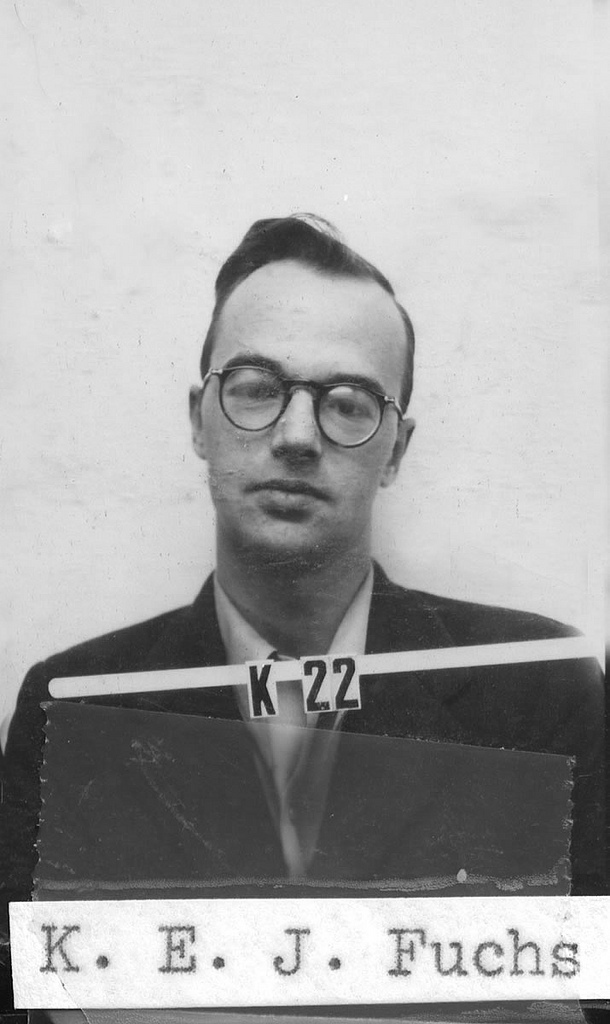Klaus Fuchs (1911-1988) was a German theoretical physicist and spy who worked at Los Alamos during the Manhattan Project and passed atomic secrets to the Soviet Union.
EARLY YEARS
Fuchs was born in Rüsselsheim, German Empire on December 29, 1911. He studied mathematics and physics at the University of Leipzig, where his father taught theology. In 1930, he joined the German Communist Party. Later, Fuchs transferred to the University of Kiel when his father became a professor of religion there.
After the Nazis came to power, Fuchs fled to England in September 1933 to avoid persecution. While in England, Fuchs worked as a research assistant at the University of Bristol to Nevill Mott, a professor of physics. He received his Ph.D. in physics in 1937. After graduation, Fuchs began working under Max Born at the University of Edinburgh, where he later earned a Ph.D. in Science.
Fuchs applied for British citizenship in 1939, but his application had not been processed by the time World War II broke out in Europe. As a result, in July 1940 Fuchs was interned as a German refugee and sent to Quebec, Canada. However, Professor Born secured his release, and Fuchs returned to Edinburgh resuming his work with Born in January 1941. In May 1941, Rudolf Peierls, co-author of the Frisch-Peierls Report, invited Fuchs to join the British atomic bomb research project, codenamed “Tube Alloys.”
Fuchs became a British citizen in August 1942 and subsequently signed the Official Secrets Act, pledging not to pass state secrets related to national security and defense to foreign governments. Yet still sympathetic to the Communist cause, Fuchs shortly thereafter began providing Soviet GRU operatives with classified information on the progress of Britain’s atomic research and development project.
In late 1943, Fuchs was part of a British delegation of scientists sent to Columbia University in New York to work on the Manhattan Project. In particular, he worked on developing the gaseous diffusion method of uranium enrichment. Seeking to continue receiving intelligence on the Anglo-American atomic bomb project, Harry Gold, a KGB agent codenamed “Raymond”, contacted Fuchs in early 1944.
MANHATTAN PROJECT ESPIONAGE
Fuchs was transferred to Los Alamos in August 1944, where he worked in the Theoretical Division under Hans Bethe and Edward Teller. There, he calculated the approximate energy yield of an atomic explosion, and specialized in researching implosion methods, focusing in particular on the “Fat Man” implosion bomb. Additionally, he was present at the Trinity Test on July 16, 1945.
Fuchs continued to spy on the Anglo-American atomic bomb project for the Soviet Union while at Los Alamos. His primary point of contact was Harry Gold, who served as a courier for a number of other spies at Los Alamos.
In addition to providing Gold with secrets on the American atomic project, Fuchs also passed detailed information about the hydrogen bomb to the Soviet Union. Some experts estimate that Fuchs’ intelligence enabled the Soviets to develop and test their own atomic bomb one to two years earlier than otherwise expected.
Following the end of the war, Fuchs returned to England and continued his work on the British atomic bomb project as the head of the Physics Department at the Harwell Atomic Energy Research Establishment.
It was not until 1949, four years after the end of the war, that decrypted cables from the United States Army Signal Intelligence Service (SIS)’s “Venona” project revealed Fuchs was a Soviet spy.
Fuchs was arrested in January 1950 and charged with violating the Official Secrets Act. He admitted to spying for the USSR and was convicted of espionage in March. Fuchs was sentenced to 14 years in prison, of which he served 9. His testimony led to the arrest of Harry Gold, David Greenglass, and Julius and Ethel Rosenberg.
LATER YEARS
Fuchs was released on June 23, 1959 and left for East Germany, where he was granted citizenship and appointed Deputy Director of the Central Institute for Nuclear Research at the Helmholtz-Zentrum Dresden-Rossendorf laboratory. He was additionally a member of the East German Academy of Sciences and 1979 recipient of the Karl Marx Medal of Honor, the highest distinction in the German Democratic Republic (GDR) for exceptional merit.
Fuchs retired in 1979 and died on January 28, 1988 at the age of 76 in East Berlin, GDR.





